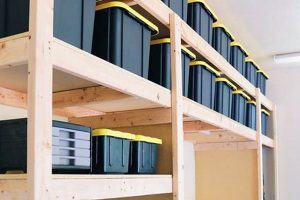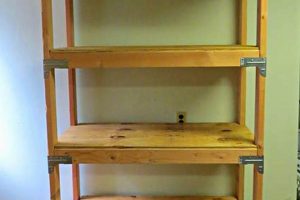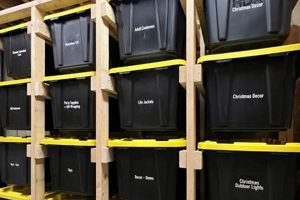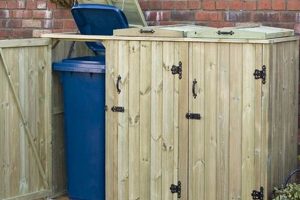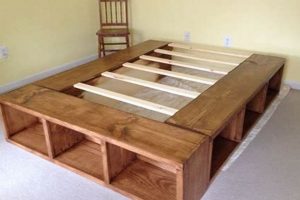The phrase encompasses self-constructed solutions for stowing personal watercraft designed for single or double paddler propulsion. These solutions range from simple wall-mounted supports to elaborate overhead pulley systems, all built by the kayak owner rather than purchased pre-assembled.
Implementing cost-effective and space-saving organizational methods is a primary motivator. Building custom racks can significantly reduce expenses compared to commercial products, especially when multiple boats require secure placement. Furthermore, crafting a personalized design allows for optimal use of available space, preventing damage and preserving the integrity of the watercraft.
Several factors influence the suitability of a self-made system. Considerations include the weight and dimensions of the boat, available space, and the skills and tools of the builder. Subsequent sections will outline materials, designs, and safety precautions applicable to different storage configurations.
DIY Kayak Storage
Optimizing self-constructed watercraft storage relies on adherence to key structural and safety principles. The following tips provide a foundation for constructing effective and lasting organizational systems.
Tip 1: Structural Integrity Assessment: Conduct a thorough evaluation of load-bearing capabilities. Identify wall studs or ceiling joists capable of supporting the combined weight of the kayak and storage apparatus. Use appropriate fasteners designed for the identified material (e.g., lag screws for wood, expansion bolts for concrete).
Tip 2: Material Selection Considerations: Prioritize rot-resistant and durable materials. Pressure-treated lumber, marine-grade plywood, and rust-resistant metal components are suitable choices for outdoor applications. Indoor storage may utilize untreated lumber if adequately sealed or painted.
Tip 3: Secure Support Systems: Design supports that evenly distribute the watercraft’s weight. Avoid concentrated pressure points that could deform the hull. Padding contact surfaces with felt, carpet, or closed-cell foam provides added protection.
Tip 4: Overhead Suspension Precautions: Implement a redundant safety system for overhead pulley installations. Utilize safety cables in addition to the primary lifting ropes or straps. Regularly inspect all components for wear or damage.
Tip 5: Clearance and Accessibility: Ensure adequate clearance for maneuvering the kayak into and out of the storage structure. Account for paddle length and personal mobility. Adhere to local building codes regarding minimum ceiling heights and aisle widths.
Tip 6: Weather Protection Strategies: Employ weather-resistant covers for watercraft stored outdoors. These covers protect against UV damage, rain, snow, and debris. Secure covers tightly to prevent wind-related displacement.
Tip 7: Periodic Inspection and Maintenance: Conduct routine inspections of the storage apparatus. Tighten loose fasteners, repair damaged supports, and replace worn or frayed ropes. Address minor issues promptly to prevent major failures.
Adhering to these guidelines enhances the longevity and safety of your watercraft storage solution, ensuring that it provides reliable support for years.
The following sections will delve into specific design examples and address common challenges encountered during the construction process.
1. Structural Support
Structural support constitutes the foundational element of any self-constructed kayak storage solution. The load-bearing capacity of the chosen design directly influences its safety and longevity. Insufficient structural integrity results in compromised stability, potentially leading to equipment damage or personal injury. For instance, a wall-mounted rack built with inadequately sized lumber may buckle under the weight of the boat, causing it to fall. Conversely, a well-engineered overhead pulley system, utilizing appropriately rated cables and secure attachment points, distributes the weight effectively, minimizing stress on individual components.
The selection of materials and the design of the support structure must correspond to the kayak’s weight and dimensions. A lightweight recreational boat may be adequately supported by a simple frame constructed from dimensional lumber. However, a heavier touring boat requires a more robust structure, potentially involving steel reinforcement or a more complex bracing system. Furthermore, the method of attachment to the building’s structure is crucial. Wall-mounted systems necessitate secure anchoring to wall studs or concrete, while ceiling-mounted systems require careful assessment of joist strength and proper fastener selection. Failure to account for these factors can compromise the integrity of the entire system.
In summary, structural support is not merely a design detail; it is the governing principle of effective watercraft organization. Proper implementation requires a thorough understanding of weight distribution, material properties, and attachment methods. Neglecting these considerations undermines the entire project, resulting in a potentially hazardous and ultimately unsustainable storage solution.
2. Material Durability
Material durability is a critical determinant of the lifespan and reliability of self-assembled kayak storage systems. The selection of inappropriate materials invariably leads to premature failure, necessitating costly repairs or complete reconstruction. For example, using untreated lumber in an outdoor rack will result in rot and eventual structural collapse due to exposure to moisture and environmental elements. Similarly, utilizing thin-gauge metal components prone to corrosion compromises the system’s load-bearing capacity over time. The consequences of material failure extend beyond mere inconvenience, potentially resulting in damage to the stored watercraft or, more seriously, personal injury.
The correlation between material choice and storage system longevity is direct and quantifiable. Pressure-treated lumber, marine-grade plywood, and powder-coated steel offer superior resistance to the degrading effects of weather, UV radiation, and physical stress. Choosing fasteners designed for outdoor use, such as stainless steel screws or galvanized bolts, prevents rust and ensures secure connections. The initial investment in durable materials yields long-term cost savings by minimizing maintenance requirements and averting structural failures. Consider the construction of a wall-mounted system; selecting high-density polyethylene for the kayak cradles, as opposed to a brittle plastic, prevents cracking under the boat’s weight, especially during temperature fluctuations.
Ultimately, the integration of durable materials is not merely a best practice; it is an essential prerequisite for a safe and sustainable storage solution. A thorough understanding of material properties and their suitability for the intended application is paramount. While cost considerations invariably play a role in material selection, prioritizing long-term performance over short-term savings is a prudent investment that mitigates risk and maximizes the utility of the storage system. This focused approach guarantees continued functionality and protection of valuable watercraft assets.
3. Space Optimization
Space optimization represents a primary impetus behind the adoption of self-constructed watercraft organizational methods. Limitations in available storage area, whether within a residential garage, shed, or outdoor setting, necessitate efficient allocation of resources. The following facets illustrate the critical role of space optimization in custom watercraft housing design.
- Vertical Utilization
Exploiting vertical space is a fundamental strategy in maximizing storage capacity within a confined area. Wall-mounted racks and overhead suspension systems effectively lift kayaks off the ground, freeing up valuable floor space for other purposes. An example includes using a pulley system to suspend a kayak from the garage ceiling, thus retaining the entire footprint of the garage floor.
- Customized Dimensions
Self-constructed solutions allow for precise tailoring of the storage structure to the specific dimensions of the kayak and the available space. Unlike prefabricated racks with fixed sizes, a customized system can be designed to fit snugly against a wall or within an alcove, eliminating wasted space. For instance, building a rack that mirrors the exact contours of the kayak hull minimizes unnecessary bulk.
- Multi-Purpose Functionality
Integrating storage for ancillary equipment, such as paddles, life vests, and spray skirts, within the kayak storage structure further enhances space optimization. A combined storage unit that houses both the boat and its associated gear consolidates resources and reduces clutter. Consider a wall-mounted rack with integrated hooks and shelves for organizing paddles and personal flotation devices.
- Adaptable Configurations
Self-constructed systems offer the flexibility to adapt to changing storage needs. A modular design allows for the addition or removal of storage bays as the number of boats changes. This adaptability ensures that the storage solution remains efficient and relevant over time. For example, a rack designed with removable supports can be easily reconfigured to accommodate a newly acquired kayak or canoe.
These facets highlight the inherent advantages of optimizing spatial arrangements in boat-specific housing. The application of these principles allows for the creation of tailored solutions that conserve space, enhance organization, and ultimately maximize the utility of available resources. Self-made systems provide an efficient avenue for realizing these gains.
4. Accessibility Ease
Accessibility ease, in the context of self-constructed kayak storage, refers to the degree to which a stored boat can be readily retrieved and returned by the user. This factor significantly impacts the frequency of boat usage and the overall convenience of the storage solution.
- Mounting Height Optimization
The vertical positioning of the storage rack directly affects the physical effort required to lift and maneuver the kayak. Lower mounting heights minimize the lifting distance, reducing strain on the user’s back and arms. Conversely, excessively high mounting positions necessitate reaching and lifting the boat overhead, increasing the risk of injury. The optimal height is contingent on the user’s physical capabilities and the boat’s weight.
- Obstruction-Free Pathways
The presence of obstacles within the pathway between the storage location and the launch point impedes accessibility. Cluttered storage areas necessitate navigating around obstructions, increasing the time and effort required to retrieve the kayak. Maintaining clear and unobstructed pathways streamlines the retrieval process and minimizes the risk of tripping or damaging the boat.
- Ergonomic Lifting Mechanisms
Incorporating lifting mechanisms, such as pulley systems or leverage-based assists, can significantly enhance accessibility for heavier boats. These mechanisms reduce the physical force required to lift the boat, making it easier for individuals with limited strength or mobility to retrieve and store their kayaks. Pulley systems, in particular, offer a mechanical advantage that multiplies the user’s lifting force.
- Secure and Easily Operated Fasteners
The design and functionality of the fasteners used to secure the kayak to the storage rack directly impact accessibility. Fasteners that are difficult to manipulate or require specialized tools impede the retrieval process. Utilizing quick-release straps, cam buckles, or other easily operated fasteners streamlines the process and minimizes the time required to secure and release the boat. Ensure a balance between ease of use and boat security.
The integration of these accessibility-focused design elements is crucial for maximizing the user-friendliness of self-made kayak storage solutions. Addressing mounting height, pathway obstructions, lifting mechanisms, and fastener design contributes to a storage system that is not only functional but also convenient and safe to use, ultimately encouraging more frequent boat usage.
5. Weather Protection
Weather protection represents a critical consideration in the design and implementation of self-constructed watercraft storage, particularly for systems located outdoors or in minimally sheltered environments. Prolonged exposure to environmental elements accelerates the degradation of kayak materials, leading to reduced performance and lifespan. Ultraviolet (UV) radiation, precipitation, temperature fluctuations, and windborne debris all contribute to this deterioration. Specifically, UV exposure causes fading, cracking, and embrittlement of plastic and composite hulls, while repeated wetting and drying cycles promote the growth of mold and mildew, compromising structural integrity. Failing to address weather-related risks negates the cost savings and customization benefits of constructing storage, as the watercraft necessitates premature repair or replacement.
Effective mitigation strategies center on creating a barrier between the kayak and the external environment. The simplest approach involves utilizing a waterproof, UV-resistant cover. High-quality covers, constructed from materials such as heavy-duty polyester or reinforced vinyl, shield the hull from direct sunlight, rain, and snow. Securing the cover with straps or bungee cords prevents wind displacement, ensuring continuous protection. More elaborate solutions involve constructing a fully enclosed shelter or canopy. These structures offer comprehensive protection from all weather elements but require greater investment in materials and construction effort. Regardless of the chosen method, proper ventilation is essential to prevent moisture buildup and the subsequent growth of mold. An improperly ventilated, fully sealed cover can create a humid environment that exacerbates mold issues.
In conclusion, weather protection is not merely an ancillary detail but a fundamental requirement for self-made kayak storage systems. Implementing appropriate protective measures significantly extends the lifespan of the watercraft, preserving its performance and aesthetic appeal. A comprehensive understanding of local climate conditions and the specific vulnerabilities of kayak materials informs the selection of effective and durable weather protection strategies, ensuring that the benefits of building the storage system are realized over the long term.
Frequently Asked Questions
This section addresses common inquiries regarding the self-construction of watercraft organizational systems, providing concise answers based on established principles of engineering and material science.
Question 1: What constitutes an acceptable safety margin when calculating load capacity for a kayak rack?
A minimum safety factor of three is recommended. This means the rack’s structural components must be capable of supporting at least three times the maximum weight of the kayak it is intended to hold. This accounts for dynamic loads, material fatigue, and unforeseen stresses.
Question 2: What is the optimal spacing between support arms on a wall-mounted kayak rack?
The spacing should be approximately one-third of the kayak’s overall length. This distribution minimizes stress concentrations and prevents hull deformation. Ensure the support arms are positioned at structural points on the kayak, such as bulkheads or frame members.
Question 3: What type of wood is most suitable for constructing an outdoor kayak rack?
Pressure-treated lumber, specifically lumber treated to a Use Category 4 (UC4) standard, is recommended. This treatment provides resistance to rot, decay, and insect infestation, ensuring long-term durability in outdoor environments. Avoid using untreated lumber, as it will quickly deteriorate.
Question 4: Is it necessary to pad the support surfaces of a kayak rack?
Yes, padding is essential to prevent abrasion and point loading. Closed-cell foam, marine-grade carpet, or durable rubber are suitable padding materials. These materials conform to the hull shape, distributing the weight evenly and preventing scratches or dents.
Question 5: How should a kayak be oriented when stored on a rack to minimize the risk of deformation?
Store the kayak hull-up or on its side, distributing the weight along the gunwales. Avoid storing the kayak hull-down for extended periods, as this can create a flat spot on the hull. Ensure the kayak is adequately supported along its entire length to prevent sagging.
Question 6: What are the key considerations when suspending a kayak from the ceiling?
Securely anchor the suspension system to ceiling joists capable of supporting the combined weight of the kayak and the system itself. Use heavy-duty ropes or straps with a high tensile strength. Incorporate a locking mechanism to prevent accidental release. Regularly inspect the ropes, straps, and hardware for wear or damage.
Adherence to these guidelines promotes the creation of watercraft organizational arrangements that are both structurally sound and long-lasting.
Subsequent sections will address specific design variations and construction techniques, offering a more detailed exploration of particular organizational approaches.
Conclusion
The preceding analysis has delineated essential aspects of self-constructed personal watercraft organizational methodologies. Proper execution, encompassing structural integrity, material durability, spatial optimization, accessibility ease, and weather protection, is paramount. These factors significantly influence the longevity of the equipment and the safety of the user. Comprehensive planning and diligent implementation represent integral components of a successful strategy.
Therefore, potential constructors should thoroughly assess their proficiency, available resources, and environmental conditions prior to embarking on the building endeavor. This proactive evaluation ensures that the resulting structure provides safe, reliable, and efficient storage for years to come. Moreover, continued vigilance in inspecting and maintaining the finished product constitutes an ongoing responsibility.


